
Figure 1. Manufacturer’s representation of an anesthesia provider adjusting the fresh gas flow on a Datascope AS-3000.
A free-standing ASC where I work has recently begun using the Datascope AS 3000 gas machines. I am concerned about the gas flow controls.
I am concerned that when one turns on nitrous oxide, both nitrous oxide and oxygen flows increase. When N2O flow is decreased, the O2 flow correspondingly decreases to its original setting.
However, when I perform a pediatric general inhalational induction, I begin with N2O and O2 in a 70-30 admixture. If the N2O is turned on first, the O2 flow rises. When the N2O flow is decreased, so too is the O2 flow. If both gases begin at 0 L/m, decreasing N2O flow will reduce O2 flow to 0 L/m. To illustrate, N2O flow is increased to 7 L/m and O2 flow rises to about 4 L/m. Using sevoflurane, when an adequate level of anesthesia is attained, flows are adjusted to a 50-50 admixture. This results in O2 flow decreasing to near zero, or 200 ml/min. This necessitates resetting the O2 flow to equal that of N2O.
Yesterday, in the pediatric ENT room, this questionable mechanism resulted in no fewer than 8 flow control knob adjustments. I feel it is inherently unsafe that O2 flow can decrease to near zero independent of someone physically turning the flow control knob. Where is the reciprocating gear mechanism that links the flow control knobs in this system? It is as if the gear system is reversed.
Again, I feel that oxygen flow should only decrease when one physically turns the O2 flow control knob. I feel this apparatus is minimally safe and maximally impractical. Further, I feel that these gas flow control knob adjustments greatly increase the workload in an already busy setting.
Thank you so much for your time and attention in this matter.
Sincerely,
Shayne Miller, CRNA
Abilene, TX
In Response:
Datascope Patient Monitoring welcomes the opportunity to discuss the differences in the AS3000’s implementation of the O2/ N2O ratio device. Anesthesia machine brands on the U.S. market today have subtle differences in their designs, and all were determined to be safe and effective devices.
The AS3000 Anesthesia System incorporates an O2/N2O ratio device that assures that at least 21% O2 is supplied in the Fresh Gas mixture when N2O is flowing.
The AS3000 design allows a user who first adjusts N2O flow to see the O2 flow rise up to an appropriate level. The AS3000 accomplishes this via a gear drive system that is activated when the user turns the N2O flow control. Competitive machines commonly use either a pneumatic control system that prevents N2O flow until sufficient O2 flow is present or a linked gear system that controls the O2/N2O ratio. The gear system in the AS3000 is designed to maintain a safe O2/N2O ratio by adding O2 flow as the user increases the N2O flow, not to maintain O2 flow at the highest flow level achieved when N2O is decreased.
When the user is adjusting N2O and O2 flow rates, redundant steps can be avoided by always adjusting the O2 flow after adjusting N2O flow if changing the desired ratio. This will assure that the desired O2 flow is achieved. We see this focus on the O2 flow control as being consistent with the clinician’s primary desire to always provide appropriate O2 flow to the patient.
Datascope Patient Monitoring frequently reviews its AS3000 Operating Instructions and In-service training materials. We will use this as an opportunity to make sure that we are informing our new users to always adjust the O2 flow after adjusting N2O flow.
We thank the reader and look forward to input from the clinician community that helps us continuously improve the AS3000.
Sincerely,
David T. Jamison
Director of Engineering, Anesthesia Systems
Datascope Patient Monitoring
Mahwah, NJ, USA


 Issue PDF
Issue PDF